
A | B | C | D | E | F | G | H | CH | I | J | K | L | M | N | O | P | Q | R | S | T | U | V | W | X | Y | Z | 0 | 1 | 2 | 3 | 4 | 5 | 6 | 7 | 8 | 9
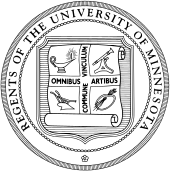 | |
Other name | U of M; The U; UMN |
|---|---|
| Motto | Commune vinculum omnibus artibus (Latin) |
Motto in English | "A common bond for all the arts" |
| Type | Public land-grant research university |
| Established | 1851[1] |
Parent institution | University of Minnesota system |
| Accreditation | HLC |
Academic affiliations | |
| Endowment | $5.366 billion (2022)[2] |
| Budget | $4.5 billion (2024)[3] |
| President | Jeff Ettinger (interim)[4] |
| Provost | Rachel Croson |
Academic staff | 4,823 (Fall 2023)[5] |
Total staff | 27,675 (Fall 2023)[5] |
| Students | 54,890 (Fall 2023)[6] |
| Undergraduates | 30,469 (Fall 2023)[6] |
| Postgraduates | 11,233 (Fall 2023)[6] |
| 5,534 (Fall 2023)[6] | |
Other students | 9,284 (Fall 2023)[6] |
| Location | , , United States 44°58′30″N 93°14′07″W / 44.97500°N 93.23528°W |
| Campus | Large city[7], 2,730 acres (1,100 ha) |
| Newspaper | Minnesota Daily |
| Colors | Maroon and gold[8] |
| Nickname | Golden Gophers |
Sporting affiliations | |
| Mascot | Goldy Gopher |
| Website | twin-cities |
 | |
The University of Minnesota (formally the University of Minnesota, Twin Cities) is a public land-grant research university in the Twin Cities of Minneapolis and Saint Paul, Minnesota, United States. The Twin Cities campus comprises locations in Minneapolis and Falcon Heights, a suburb of St. Paul, approximately 3 mi (4.8 km) apart.[9]
The Twin Cities campus is the oldest and largest in the University of Minnesota system and has the ninth-largest (As of the 2022-2023 academic year) main campus student body in the United States, with 54,890 students at the start of the 2023–24 academic year.[10] It is the flagship institution of the University of Minnesota System, and is organized into 19 colleges, schools, and other major academic units.
The Minnesota Territorial Legislature drafted a charter for the University of Minnesota as a territorial university in 1851, seven years before Minnesota became a state. The university is currently classified among "R1: Doctoral Universities – Very high research activity".[11] It is a member of the Association of American Universities. The National Science Foundation ranked University of Minnesota 22nd among American universities for research and development expenditures in 2022 with $1.202 billion.[12][13] The University of Minnesota is considered a Public Ivy university.[14]
The Minnesota Golden Gophers compete in 21 intercollegiate sports in the NCAA Division I Big Ten Conference and have won 29 national championships.[15][16] As of March 2024, Minnesota's current and former students have won a total of 90 Olympic medals.[17]
History
This section needs expansion. You can help by adding to it. (March 2020) |
The University of Minnesota was founded in Minneapolis in 1851 as a college preparatory school, seven years prior to Minnesota's statehood.[9] It struggled in its early years and relied on donations to stay open from donors including South Carolina Governor William Aiken Jr.[18][19]
In 1867, the university received land grant status through the Morrill Act of 1862.[20][21] With lands taken from Dakota people, the University was able to revive itself after closing in 1858.[22] The Dakota people have not been credited for the expropriation of their lands.[22]
An 1876 donation from flour miller John S. Pillsbury is generally credited with saving the school.[18][19] Since then, Pillsbury has become known as "The Father of the University".[23] Pillsbury Hall is named in his honor.[24][25]
Academic milestones began with Warren Clark Eustis and Henry Martyn Williamson graduating in 1873 as the university's first graduates.[26] Helen Marr Ely followed as the first female graduate in 1875.[26] The university progressed by awarding its first master's degree in 1880 and conferring its first Ph.D. in 1888.[26]
As the 20th century began, the university expanded its academic offering. In 1908, the university inaugurated the Program of Mortuary Science, becoming the first state university in the United States to do so.[26] The School of Nursing was established in 1909, the first continuous nursing school on a university campus in the United States; the nursing school later opened its doors to male students in 1949.[26]
20th-century breakthroughs at the University of Minnesota positioned it as a leader in medical innovation. In 1954, C. Walton Lillehei and F. John Lewis performed the world's first successful open-heart surgery using cross-circulation.[26] 1955 saw Richard DeWall and Lillehei develop the bubble oxygenator, setting the stage for modern heart-lung machines.[26] This was followed by Lillehei's performance of the first artificial heart valve implant in a human in 1958, and in the same year, Earl Bakken, co-founder of Medtronic, Inc., developed the first portable pacemaker, introduced into practice by Lillehei.[26]
The latter part of the 20th century saw the university's continued innovation in medical transplantation, including the world's first successful kidney/pancreas transplant in 1967, bone marrow transplant in 1968, and living donor pancreas transplant in 1998.[26] Another notable contribution to agriculture came in 1991, with the development of the Honeycrisp apple.[26]
Academics
Organization and administration
The university is organized into 19 colleges, schools, and other major academic units:[27]
- Center for Allied Health Programs
- College of Biological Sciences
- College of Continuing and Professional Studies
- School of Dentistry
- College of Design
- College of Education and Human Development
- College of Food, Agricultural and Natural Resource Sciences
- Graduate School
- Law School
- College of Liberal Arts
- Carlson School of Management
- Medical School
- School of Nursing
- College of Pharmacy
- Hubert H. Humphrey School of Public Affairs
- School of Public Health
- College of Science and Engineering
- College of Veterinary Medicine
Institutes and centers
Six university-wide interdisciplinary centers and institutes work across collegiate lines:[28]
- Center for Cognitive Sciences
- Consortium on Law and Values in Health, Environment, and the Life Sciences
- Institute for Advanced Study, University of Minnesota
- Institute for Engineering in Medicine
- Institute for Translational Neuroscience
- Institute on the Environment
- Minnesota Population Center
Rankings
|
|
| ||||||||||||||||||||||||||||||||||||||||||||||||||||||||||||||||||||||||||||||||||||||||||||||||||||||||||||||||||||||||||||||||||||||||||||||||||||||||||||
Global
In 2021, the University of Minnesota was ranked as the 40th best university in the world by the Academic Ranking of World Universities (ARWU), which assesses academic and research performance.[40] The same 2021 ranking by subject placed the University of Minnesota's ecology program as 2nd best in the world, management program as 10th best, biotechnology program as 11th best, mechanical engineering and medical technology programs as 14th best, law and psychology programs as 19th best, and veterinary sciences program as 20th best.[40] The Center for World University Rankings (CWUR) for 2021–22 ranked Minnesota 46th in the world and 26th in the United States.[41] The 2021 Nature Index, which assesses the institutions that dominate high-quality research output, ranked Minnesota 53rd in the world based on research publication data from 2020.[42] U.S. News & World Report ranked Minnesota as the 47th best global university for 2021.[43] The 2015 Times Higher Education World University Rankings placed Minnesota 46th worldwide, based primarily on teaching, research, knowledge transfer, and international outlook.[44]
National
In 2021, Minnesota was ranked as the 24th best university in the United States by the Academic Ranking of World Universities,[45] and 20th in the United States in Washington Monthly's 2021 National University Rankings.[46] Minnesota's undergraduate program was ranked 53th among national universities by U.S. News & World Report for 2023, and 23rd in the nation among public colleges and universities.[47] The same publication ranked Minnesota's graduate Carlson School of Management as 28th in the nation among business schools, and 6th in the nation for its information systems graduate program.[48] Other graduate schools ranked highly by U.S. News & World Report for 2022 include the University of Minnesota Law School at 22nd, the University of Minnesota Medical School, which was 4th for family medicine and 5th for primary care, the University of Minnesota College of Pharmacy, which ranked 3rd, the Hubert H. Humphrey School of Public Affairs, which ranked 9th, the University of Minnesota College of Education and Human Development, which ranked 10th for education psychology and special education, and the University of Minnesota School of Public Health, which ranked 10th.[48]
In 2020, the Center for Measuring University Performance ranked Minnesota 16th in the nation in terms of total research, 30th in endowment assets, 24th in annual giving, 28th in the number of National Academies of Sciences, Engineering and Medicine memberships, 9th in its number of faculty awards, and 14th in its number of National Merit Scholars.[49] Minnesota is listed as a "Public Ivy" in 2001 Greenes' Guides The Public Ivies: America's Flagship Public Universities.[50]
Undergraduate admissions
| Undergraduate admissions statistics | |
|---|---|
2023 entering class[51] | |
| Test scores middle 50%[i] | |
| SAT Total | 1340–1490 (among 50% of FTFs) |
| ACT Composite | 27–32 (among 50% of FTFs) |
| |
For the Class of 2027 (enrolled fall 2023), Minnesota received more than 39,000 applications. The Class of 2027 consisted of approximately 6,700 students.
Of the 50% of enrolled freshmen in 2023 who submitted ACT scores; the middle 50 percent Composite score was between 27 and 32.[51] Of the 50% of the incoming freshman class who submitted SAT scores; the middle 50 percent Composite scores were 1340–1490.[51]
The University of Minnesota is a college sponsor of the National Merit Scholarship Program and sponsored 97 Merit Scholarship awards in 2020. In the 2020–2021 academic year, 112 freshman students were National Merit Scholars.[52]
Discoveries and innovation
Inventions by University of Minnesota students and faculty have ranged from food science to health technologies. Most of the public research funding in Minnesota is funneled to the University of Minnesota as a result of long-standing advocacy by the university itself.
The university developed Gopher,[53] a precursor to the World Wide Web which used hyperlinks to connect documents across computers on the internet. However, the version produced by CERN was favored by the public since it was freely distributed and could more easily handle multimedia webpages.[54] The university also houses the Charles Babbage Institute, a research and archive center specializing in computer history. The department has strong roots in the early days of supercomputing with Seymour Cray of Cray supercomputers.[55]
The university also became a member of the Laser Interferometer Gravitational-wave Observatory (LIGO) in 2007 and has led data analysis projects searching for gravitational waves — their existence was confirmed by scientists in February 2016.[56]
Discoveries and innovation by faculty or alumni include:
- Puffed rice – Alexander P. Anderson performed work leading to the discovery of "puffed rice", a starting point for a new breakfast cereal later advertised as "Food Shot From Guns".[57]
- Transistorized cardiac pacemaker – Earl Bakken founded Medtronic, where he developed the first external, battery-operated, transistorized, wearable artificial pacemaker in 1957.
- Green Revolution – Norman Borlaug was an American agronomist who led initiatives worldwide that contributed to extensive increases in agricultural production termed the Green Revolution. Borlaug, often called "the father of the Green Revolution", is credited with saving over a billion people worldwide from starvation. Borlaug was awarded multiple honors for his work, including the Nobel Peace Prize, the Presidential Medal of Freedom, and the Congressional Gold Medal.
- ATP synthase – Paul D. Boyer elucidated the enzymatic mechanism for synthesis of the cellular "energy currency", adenosine triphosphate (ATP), leading to a Nobel Prize in Chemistry, 1997.
- Point-contact transistor – Walter Houser Brattain and John Bardeen, later joined by William Shockley, invented the point-contact transistor in December 1947. For their invention, the trio was awarded a Nobel Prize in Physics in 1956.
- Infusion pump – Henry Buchwald invented the world's first infusion port, peritoneovenous shunts, and specialty vascular catheters. He also invented the first implantable infusion pump, a precursor to implantable infusion pumps in use throughout the world today.
- Photosynthesis – Melvin Calvin discovered the Calvin cycle along with Andrew Benson and James Bassham; for this, he won the 1961 Nobel Prize in Chemistry.
- Ecology – Raymond Lindeman revolutionized ecology, primarily through his 1942 paper "Trophic Dynamic Aspect of Ecology", which described how energy and nutrients cycled through ecosystems.
- Supercomputer – Seymour Cray designed a series of computers that were the fastest in the world for decades, and founded Cray Research, which built many of these machines.
- Taconite – Edward Wilson Davis developed an engineering process to economically extract iron ore from hard taconite rocks, making taconite valuable as iron ore for the iron and steel industries.
- Cosmic rays – Phyllis S. Freier discovered the presence of heavy nuclei in cosmic rays, proving the similarity between the Solar System and the rest of the galaxy.
- U.S. aviation – Robert Rowe Gilruth led the development of flying qualities for airplanes, the use of rockets to achieve data at supersonic speeds, and the establishment of many of the nation's leading flight research and human space flight operations facilities.
- Bone marrow transplant – Robert A. Good in 1968 performed the first successful human bone marrow transplant between persons who were not identical twins and is regarded as a founder of modern immunology. In 2018 Minnesota Gov. Mark Dayton proclaimed August 24 as University of Minnesota Blood and Marrow Transplant Day.
- Gore-Tex – Robert Gore invented Gore-Tex materials in 1969.
- Disk drive – Reynold B. Johnson invented a method and machinery to score tests electronically.
- K-rations – Ancel Keys developed the rations for the U.S. military and also conducted dietary studies: the Minnesota Starvation Study and the Seven Countries Study.
- Synthetic rubber – Izaak Kolthoff developed the "cold process" for producing synthetic rubber, which he undertook under the U.S. synthetic rubber program during World War II.
- Cyclotron – Ernest Lawrence won the Nobel Prize for Physics 1939 for inventing and developing the cyclotron.
- Drosophila melanogaster – Edward Lewis won the Nobel Prize in Physiology or Medicine in 1995 for his work on the Drosophila bithorax complex of homeotic genes.
- Cardiac surgery – C. Walton Lillehei pioneered open-heart surgery, as well as numerous techniques, equipment, and prostheses for cardiothoracic surgery.
- POPmail – Mark P. McCahill led the development of the Gopher protocol, the effective predecessor of the World Wide Web; was involved in creating and codifying the standard for Uniform Resource Locators (URLs); and led the development of POPmail, one of the first e-mail clients, which had a foundational influence on later e-mail clients and the popularization of graphical user interfaces in Internet technologies more broadly.
- MMPI – Starke R. Hathaway and J. C. McKinley created the Minnesota Multiphasic Personality Inventory (MMPI), which was first published in 1943.
- Zatocoding – Calvin Mooers developed a mechanical system using superimposed codes of descriptors for information retrieval called Zatocoding, 1948.
- Atomic bomb – Edward P. Ney discovered cosmic ray heavy nuclei and solar proton events. After early work involving separating isotopes from uranium, he worked on the Manhattan Project.
- Atomic bomb – Alfred O. C. Nier devised a method to isolate the isotopes of uranium, a critical discovery in the atomic age. Nier worked with Kellex Corporation in New York City on the design and development of efficient and effective mass spectrographs for use in the Manhattan Project to build the atomic bomb in World War II. He designed most of the spectrographs used for monitoring uranium separations during the war.
- Atomic bomb – Frank Oppenheimer worked on uranium isotope separation in 1945 and joined the Manhattan Project.
- Biotechnology – Ronald L. Phillips was the first to generate whole corn plants from cells grown in culture, which laid the foundation for, and sparked, a new industry using cell-culture methods to genetically modify corn plants and other cereals. The corn cell line most widely used for genetic modification of corn has greatly accelerated the improvement of corn as food, feed, and fuel.
- Renewable energy – Lanny D. Schmidt designed a reactor to extract hydrogen from ethanol, offering the first real hope hydrogen could be a source of inexpensive and renewable energy.
- Biomimetics – Otto Schmitt invented the Schmitt trigger, the cathode follower, the differential amplifier, and the chopper-stabilized amplifier.
- NASA – Deke Slayton was one of the original NASA Mercury Seven astronauts and became NASA's first chief of the Astronaut Office. He served as NASA's director of flight crew operations, making him responsible for crew assignments at NASA, from November 1963 until March 1972. At that time, he was granted medical clearance to fly and was assigned as the docking module pilot of the 1975 Apollo–Soyuz Test Project, at age 51 becoming the oldest person to fly in space at the time.
- Bathythermograph – Athelstan Spilhaus fully developed the bathythermograph (BT) in 1938, an instrument he perfected that was of vital importance in World War II against the German U-boat. During the war, the BT became standard equipment on all U.S. Navy subs and vessels involved in antisubmarine warfare.
- CDC 6600 – James Thornton developed the CDC 6600, the world's first supercomputer, designed with Seymour Cray.
- Ziagen – Robert Vince worked on antiviral drug candidates at UMN, where he went on to develop carbocyclic nucleosides termed 'carbovirs.' This class of medicinal agents included the drug abacavir. Abacavir was commercialized by GlaxoSmithKline as Ziagen for the treatment of AIDS.
- US3D – Graham Candler pioneered the future of hypersonics research with the development of the US3D CFD code which builds off of NASA's DPLR code, but uses unstructured grids and has many advanced numerical capabilities and physical models for multi-physics, highly coupled problems.
Campuses
Demographics: Twin Cities (Minneapolis and St. Paul) campus
Note: The flagship University of Minnesota campus is the Twin Cities campus, which comprises grounds in St. Paul and Minneapolis, the latter divided into areas on both the east and west banks of the Mississippi River. Administratively, these are all one campus, but for purposes of simplicity, this article will apply "campus" to its component parts where necessary to avoid confusion with the names of cities.
As the largest of five campuses across the University of Minnesota system, the Twin Cities campus has more than 50,000 students; this makes it the ninth-largest campus student body in the United States overall. It also has more than 300 research, education, and outreach centers and institutes, on everything from the life sciences to public policy and technology.[56]
The university (system-wide) offers 154 undergraduate degree programs, 24 undergraduate certificates, 307 graduate degree programs, and 79 graduate certificates. The university offers the majority of these programs and certificates at its Twin Cities campus.[58] The university has all three branches of the Reserve Officer Training Corps (ROTC).[59] The Twin Cities campus, as well as the campuses at Crookston, Duluth, Morris, and Rochester, are accredited by the Higher Learning Commission (HLC).[60]
The racial/ethnic breakdown of the student population is: 56.2% White, 13.4% Asian, 9.5% International Students (that are undesignated race/ethnicity) 8.5% Black, 5.6% Hispanic/Latino, 4.8% Unknown, 1.7% American/Native American Indian, and 0.2% Hawaiian. Among matriculants to the university, 66.8% are considered Minnesota residents and 33.2% are considered out-of-state residents. According to the University Office of Institutional Data and Research, as of fall 2023 there were 30,469 undergraduates at the University of Minnesota Twin Cities campus. Of that number, 6,736 were first-time, degree-seeking freshmen. There were 11,233 graduate students.[61]
Minneapolis campus
The original Minneapolis campus overlooked the Saint Anthony Falls on the Mississippi River, but it was later moved about a mile (1.6 km) downstream to its current location. The original site is now marked by a small park known as Chute Square at the intersection of University and Central Avenues. The school shut down following a financial crisis during the American Civil War, but reopened in 1867 with considerable financial help from John S. Pillsbury. It was upgraded from a preparatory school to a college in 1869. Today, the university's Minneapolis campus is divided by the Mississippi River into an East and West Bank. The East Bank, the main portion of the campus, covers 307 acres (124 ha). The West Bank is home to the University of Minnesota Law School, the Humphrey School of Public Affairs, the Carlson School of Management, various social science buildings, and the performing arts center.
The Minneapolis campus has several residence halls: 17th Avenue Hall, Centennial Hall, Frontier Hall, Territorial Hall, Pioneer Hall, Sanford Hall, Wilkins Hall, Middlebrook Hall, Yudof Hall, and Comstock Hall.
East Bank
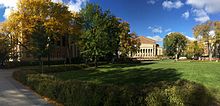
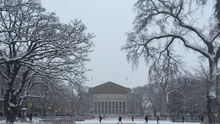

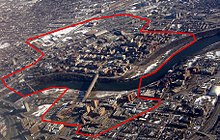
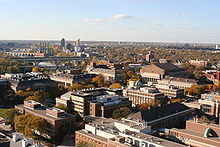

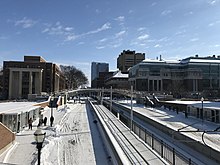
To help ease navigation of the large campus, the university has divided the East Bank into several areas: the Knoll area, the Mall area, the Health area, the Athletic area, and the Gateway area.
The Knoll area, the oldest extant part of the university, is in the northwestern corner of the campus.[62] Many buildings in this area are well over 100 years old, such as some of the 13 in the Old Campus Historic District.[63] Today, most disciplines in this area relate to the humanities. Burton Hall is home to the College of Education and Human Development. Folwell Hall and Jones Hall are primarily used by the language departments. A residence hall, Sanford Hall, and a student-apartment complex, Roy Wilkins Hall, are in this area. This area is just south of the Dinkytown neighborhood and business area.
Northrop Mall, or the Mall area, is arguably the center of the Minneapolis campus. The plan for the Mall was based on a design by Cass Gilbert, although his scheme was too extravagant to be fully implemented.[64] Several of the campus's primary buildings surround the Mall area. Northrop Auditorium provides a northern anchor, with Coffman Memorial Union (CMU) to the south. Four of the larger buildings to the sides of the Mall are the primary mathematics, physics, and chemistry buildings (Vincent Hall, Tate Laboratory and Smith Hall, respectively) and Walter Library. Smith Hall and Walter Library were built during the Lotus Coffman administration.[65] The Mall area is home to the College of Liberal Arts, which is Minnesota's largest public or private college, and the College of Science and Engineering. Behind CMU is another residence hall, Comstock Hall, and another student-apartment complex, Yudof Hall. The Northrop Mall Historic District was formally listed in the National Register of Historic Places in January 2018.[66]
The Health area is to the southeast of the Mall area and focuses on undergraduate buildings for biological science students, as well as the homes of the College of Pharmacy, the School of Nursing, the School of Dentistry, the Medical School, the School of Public Health, and M Health Fairview Hospitals and Clinics. This complex of buildings forms what is known as the University of Minnesota Medical Center. Part of the College of Biological Sciences is housed in this area.
Across the street from the University of Minnesota Medical Center Fairview is an area known as the "Superblock", a four-city-block space comprising four residence halls (Pioneer, Frontier, Centennial and Territorial Halls). The Superblock is one of the most popular locations for on-campus housing because it has the largest concentration of students living on campus and has a multitude of social activities between the residence halls.
The Athletic area is directly north of the Superblock and includes four recreation/athletic facilities: the University Recreation Center, Cooke Hall, the University Fieldhouse, and the University Aquatic Center. These facilities are all connected by tunnels and skyways, allowing students to use one locker room facility. North of this complex is the Huntington Bank Stadium, Williams Arena, Mariucci Arena, Ridder Arena, and the Baseline Tennis Center.
The Gateway area, the easternmost section of campus, is primarily composed of office buildings instead of classrooms and lecture halls. The most prominent building is McNamara Alumni Center. The university is also heavily invested in a biomedical research initiative and has built five biomedical research buildings that form a biomedical complex directly north of Huntington Bank Stadium.
Notable architecture
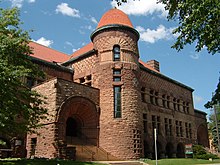

The Armory, northeast of the Mall area, is built like a Norman castle. It features a sally-port entrance facing Church Street and a tower that was originally intended to be the professor of military science's residence. Since it originally held the athletics department, the Armory also features a gymnasium. Today it is home to military science classes and the university's Reserve Officers' Training Corps.
Several buildings in the Old Campus Historic District were designed by early Minnesota architect LeRoy Buffington. One of the most notable is Pillsbury Hall, designed by Buffington and Harvey Ellis in the Richardsonian Romanesque style. Pillsbury Hall's polychromatic facade incorporates several sandstone varieties that were available in Minnesota during the time of construction. Buffington also designed the exterior of Burton Hall, considered one of the strongest specimens of Greek Revival architecture in Minnesota.
Many of the buildings on the East Bank were designed by the prolific Minnesota architect Clarence H. Johnston, including the Jacobean Folwell Hall and the Beaux-Arts edifices of Northrop Auditorium and Walter Library, which he considered the heart of the university. Johnston's son, Clarence Johnston Jr, was also an architect and designed the original Bell Museum building and Coffman Memorial Union in the 1930s.
The Malcolm Moos Health Sciences Tower, which is the tallest building on the Twin Cities campus, is a noted example of brutalist architecture.
In more recent years, Frank Gehry designed the Frederick R. Weisman Art Museum. Completed in 1993, the Weisman Art Museum is a typical example of his work with curving metallic structures. The abstract structure is considered highly significant because it was built prior to the widespread use of computer-aided design in architecture. It also ushered in a new era of architecture at the university, which continued with the completion of the McNamara Alumni Center in 2000 and Bruininks Hall (formerly STSS) in 2010.
Another notable structure is the addition to the Architecture building, designed by Steven Holl and completed in 2002. It won an American Institute of Architects award for its innovative design. The Architecture building was then renamed Rapson Hall after the local modernist architect and School of Architecture Dean Ralph Rapson.
The university also has a "Greek row" of historic fraternities and sororities located north of campus on University Avenue SE.
West Bank

Text je dostupný za podmienok Creative Commons Attribution/Share-Alike License 3.0 Unported; prípadne za ďalších podmienok. Podrobnejšie informácie nájdete na stránke Podmienky použitia.
Antropológia
Aplikované vedy
Bibliometria
Dejiny vedy
Encyklopédie
Filozofia vedy
Forenzné vedy
Humanitné vedy
Knižničná veda
Kryogenika
Kryptológia
Kulturológia
Literárna veda
Medzidisciplinárne oblasti
Metódy kvantitatívnej analýzy
Metavedy
Metodika
Text je dostupný za podmienok Creative
Commons Attribution/Share-Alike License 3.0 Unported; prípadne za ďalších
podmienok.
Podrobnejšie informácie nájdete na stránke Podmienky
použitia.
www.astronomia.sk | www.biologia.sk | www.botanika.sk | www.dejiny.sk | www.economy.sk | www.elektrotechnika.sk | www.estetika.sk | www.farmakologia.sk | www.filozofia.sk | Fyzika | www.futurologia.sk | www.genetika.sk | www.chemia.sk | www.lingvistika.sk | www.politologia.sk | www.psychologia.sk | www.sexuologia.sk | www.sociologia.sk | www.veda.sk I www.zoologia.sk
